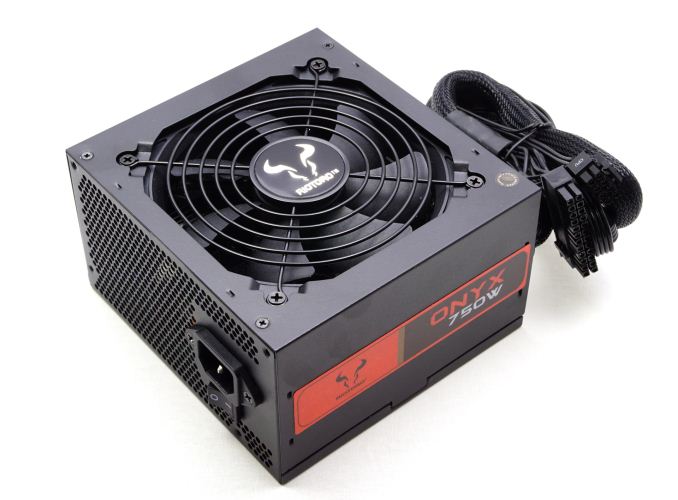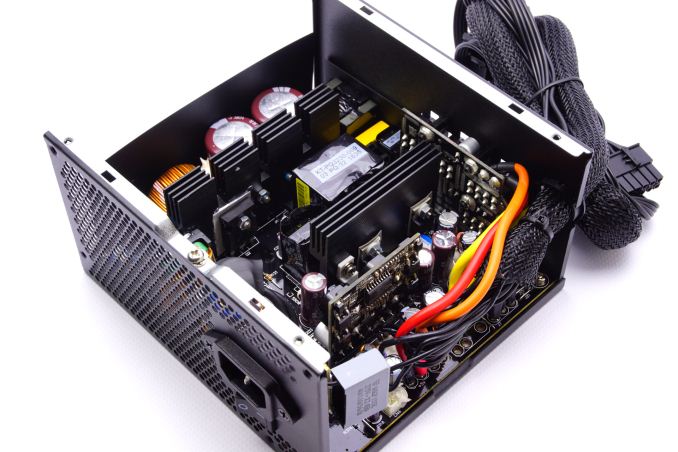The Riotoro Onyx Power Supply Review: 650W & 750W Tested
by E. Fylladitakis on March 23, 2017 10:00 AM ESTConclusion
In this review we examined two of Riotoro’s first power supply units, the Onyx 650W and the Onyx 750W. The company’s approach is simple, attempting to deliver quality but also a reasonably priced unit for home PCs and casual gaming systems. It was never their goal to market PSUs with astounding performance figures or fancy designs - Riotoro wanted PSUs that would appeal to the bulk of the market, which largely consists of regular users and casual gamers.
Perhaps the strongest selling point of the Riotoro Onyx PSUs is their build quality. Great Wall may not be a well-known OEM in the North American and European markets, but they are an old and experienced manufacturer. Riotoro made good components choices as well, especially with the all-Japanese capacitors, which is a very rare sight into products that are designed to mainly compete in terms of pricing. Our only concern lies with the sleeve bearing Yate-Loon fan, which is the weakest link of the whole unit - anecdotally these fan models tend to fail after some years. However the fan should easily outlive the unit’s three-year warranty and beyond, but we would still rather find better quality fans into these units.
The overall performance of the Onyx PSUs is very good. Both units displayed high-efficiency readings at light and heavy loads, as well as proper filtering and regulation on all of their voltage lines. They also maintain low noise levels when they are operating in good environmental conditions or heavily loaded for prolonged periods of time. However, due to the high internal temperatures that occur with the units heavily loaded when operating under harsh environmental conditions, we would not recommend using the Onyx for systems that maintain heavy loads for prolonged periods of time with perhaps limited cooling (e.g. cryptocurrency miners), as the stress will certainly have a serious impact on the longevity of the units.
The MSRP prices of the Onyx 650W and Onyx 750W PSUs are $80 and $90 respectively, but we already see both units selling for $10 less each depending on the retailer. The company currently also has a running campaign that gives customers an extra 10% off and free shipping for units preordered via their website. These are reasonable prices considering the quality and performance of the units and so we believe that Riotoro has fully attained their goal to design a competitive PSU for today’s PC market. After the company’s campaign expires, the success of the Onyx series will depend on its availability and Riotoro’s ability to survive the price war that their competitors will undoubtedly silently declare.
Suggested Reading
- The SilverStone SX700-LPT SFX 700W PSU Review
- The SilverStone ST60F-TI Strider Titanium 600W PSU Review
- The Raidmax RX-700AT 700W 80Plus Titanium Power Supply Review
- Best PC Power Supplies: Holiday 2016












32 Comments
View All Comments
Cellar Door - Wednesday, March 29, 2017 - link
Nobody cares that you had a PSU fail - there are plenty of new companies that make great products and there are plenty of old companies that make bad products.Aaannnndd nobody cares what you are going to do.
t4murphy - Sunday, March 26, 2017 - link
Same here. Been using my 750 silencer for 9 yrs. Couple SLI builds and MoBo no. 5 still going strongBrokenCrayons - Friday, March 24, 2017 - link
Aw, be nice to them. They get a lot of unwarranted abuse from people already.bigboxes - Friday, March 24, 2017 - link
Yeah, I bought a FSP (Fortran) 700 watt power supply in 2006 for my first dual core build. I could've swore that AnandTech had recommended the damn thing. Can't find a link to support that. Guess my memory is going. I tried out FSP as alternative when Antech was going through their QC issues. That PSU lasted maybe a year and then died in a puff of smoke. Was so pissed. Lot of money down the drain. I had bought a Seasonic PSU for my file server and liked it enough that I went to Seasonic for my main rig on my next build. I spend the money now for reliability as my boxes remain up 24/7. No more unknown cheap knock off brands for boxes.kn00tcn - Wednesday, March 29, 2017 - link
fsp is known to be one of the highest quality makers together with seasonic, both of them are suppliers to other brands like corsairyou people with your ignorance & single model failure stories that somehow represent an entire brand...
lefizz - Monday, March 27, 2017 - link
I bought a Tagan when they first came out probably based on the review. 18 months laters in took out my motherboard and cpu. Probably £400 worth of damage, luckily i was next to it when it failed or else i could have started a fire.On a side not i was working in an studio in London in the early 2000s and a few of the Dell workstations went up in smoke in spectacular fashion from damaged USB ports on the front. On one occasion one literally filled the studio with smoke in the 5 seconds it took for me to turn around and turn the machine off. It was a big studio, like a smoke bomb going off.
rocky12345 - Thursday, March 30, 2017 - link
I. had the same 700 watt Tagan was a great PSU. 2007-2014 I got my money's out of it. Heck it powered a Q6600@3.8Ghz Geforce 9800 GT ,Radeon HD 4870x2,Georce 580 & 680 GTX cards all overclocked over the years. What finally got it was a spider crawled into it and zap a flash of light and system went off.I took the cover off that's where I seen fried spider lol. I cleaned it up plugged it into a junker system and it worked fine. It worked two more years after the short out. Actually it still works I just upgraded to a newer unit. So either you got a bad unit or it was always running hot as the fans where small on those units. I was bummed when I found out they were gone.
DanNeely - Thursday, March 23, 2017 - link
BFG lasted from 2002 to 2010,when bought your card (2008 or later) they were a well established and highly recommended company at time; not an unknown upstart. And if their lifetime warranty was extravagant EVGA and XFX were both offering IIRC 5 years at the time. Both of the latter reduced theirs because of, and IIRC BFG was broken by, the rise of GPU compute and Crypto Coin mining resulting in much higher lifetime load times and consequently much higher than budgeted for failure rates.DanNeely - Thursday, March 23, 2017 - link
The really long warranties were also semi-supported for by nVidia insisting on card makers taking large numbers of low end GPUs to get full access to the premium parts. This stuck them with more budget cards than they could easily sell, a number of them were used up providing warranty replacements for similar performing older high end cards. eg my GTX6800 was replaced with a GT8500 when 3 or 4 years old.feelingshorter - Thursday, March 23, 2017 - link
I owned a BFG 6600GT and that dates back to 2005 and then bought a 8800GT as well, which was before compute or CUDA cores. Wasn't until the 8800GTX that CUDA cores even came on the market. I don't even remember any notable use for compute back then, even wikipedia says Bitcoin was founded in 2009 and earliest reviews for the 8800GTX was 2006. Feels like BFG failed due to the warranties because GPUs start to fail en mass right after 2 years more so than over usage of compute for mining.